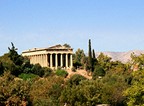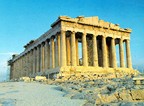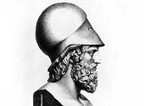The Classical Period of the Greece which was from the 6th to 4th centuries is the most eminent and popular era of Greek history. During the peak of this classical period (around 5th century BC), was the time when the foundations and bases of western civilization were laid in Athens. This state became the most powerful naval force of Greece and establishedits reach in all purviewsof culture, including drama, philosophy, rhetorics, music and to new concept of democracy.
Immediately after the victory over the Persians, the winning residents of the city of Athens had the task to rebuild their devastated city. The first concern of Themistocles was to wall the city with strong walls that encompass the entire city, the port of Piraeus and the road connecting the two cities. They were named because of their length “Long Walls” are known until today as “Themistoclean wall”. The walls were built fast because the Spartans were already reacting. But it was too late. Another blow to the strategic control of the Aegean Sea for the Spartans was delivered when the Athenians in 477 BC refused their help and kept for themselves together with their allies the control of the Aegean Sea and of the great strategic trade routes to the Black Sea, enabling them to have access to cereals and other paramount goods.
Thus an alliance under the Athenians was formed that was slowly turned into the Athenian hegemony over many other cities of Asia Minor and the Aegean that their number reached nearly 150. Theoretically the funds of the alliance were kept in public at the sanctuary of the island of Delos, but in practice they were only managed by the Athenians. Soon with the money of all the cities a powerful fleet was formed that was controlled by the Athenians and was supposed to protect all the cities of the alliance but in reality it only protected the interests of the Athenians. This fleet under Cimon defeated the Persian fleet once more in 468 BC. Since then, any attempt of a city to leave the alliance led to its suffering, even its destruction (Naxos, Thasos etc).
The large fleet of Athens offered job to thousands of people of lower classes who could not have their own weapons and belong in the ranks of the infantry. The long absence in the naval missions enabled the nobles to take back significant privileges they had lost. Also the Athenians led by Cimon, son of Miltiades repulsed the Persians in Asia Minor and consolidated in Thrace and Skyros, where he “discovered” the bones of the mythical hero Theseus and transferred them back to the city with great honors. During the absence of Kimon at the campaigns, an Athenian democratic, Ephialtes, made several reforms that gave strength to many people through the process of the lottery office.
Around 450 BC Pericles appears on the scene and takes over the city. His first concern was to bring the alliance funds from Delos to Athens and the money to finance the reconstruction of Athens, much of which was still in ruins from the time of the Persian wars. In 458 a huge bronze statue of Promachos Athena by Pheidias had already been erected on the Acropolis, which dominated throughout Athens and was the first visible item by the sea for anyone approaching the coast of Attica
Of course, the greatest work of Pericles was the grand redesign of the Acropolis by Phidias, Iktinos and Kallikrates. The most magnificent of all the new projects was the new Parthenon built entirely with white Pentelic marble and adorned inside with the gold and ivory statue of Goddess created by Phidias. The Parthenon was complemented by the magnificent street and the Propylaea of the Acropolis, designed by Mnesicles.
At the same time great personalities lived and worked in the city such as the historian of the Persian Wars, Herodotus and dramatists Aeschylus, Sophocles and Euripides with his immortal works which are still played and fascinate mankind.


